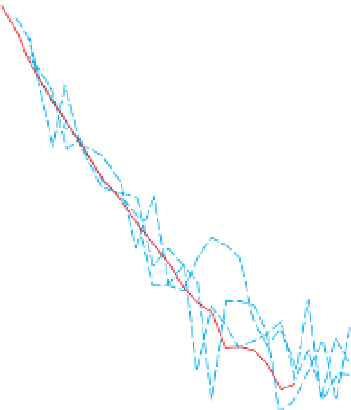Geoscience Reference
In-Depth Information
noise components will cancel leaving only the signal. The
signal to (random) noise ratio is improved by a factor of
10
-7
p
, where N is the number of repeat measurements.
Stacking is implemented in many geophysical instru-
ments. In these cases, the instruments are capable of auto-
matically making repeat readings with the measurement
recorded being some kind of average of these. In some
instruments the values are explicitly compared and
recording continues until some level of consistency is
achieved, usually based on the standard deviation of the
measurements. Alternatively, stacking may be undertaken
during post-survey data processing.
Stacking is highly effective where a measurement is made
at a fixed location i.e. during ground and downhole
surveying, and over a time period of suf
50 Measurements
5000 Measurements
10
-8
10
-9
10
-10
10
-11
10
-2
10
-1
10
0
10
1
cient duration so
as to observe enough repetitions of the signal. A disadvantage
of stacking is that it increases the time required to make a
measurement. For moving survey platforms, stacking is not
as effective because the signal is continually changing as the
survey system passes over the ground, so only a smaller
number of stacks are possible before distorting the signal
too much.
Delay time (ms)
Figure 2.19
Stacking or summation (averaging) of repeat
recordings of a repetitive EM signal; the time-varying magnetic field
Note the significant reduction in noise in the time series comprising
5000 stacked measurements. Redrawn, with permission, from
Sorenson et al.(
2006
).
It is important to appreciate that a variety of enhancement
methods, applied sequentially, may be required in order to
obtain the desired enhancement of a dataset. Examples are
presented in
Sections 2.7.4.5
and
6.5.2.3
.
2.7.4.2
Ratios
When measurements are multichannel, i.e. comprising a
series of individual readings, it can be useful to display the
ratios of pairs of readings. The ratio of two channels A and
B is simply A divided by B, and its reciprocal ratio is
B divided by A. Multichannel geophysical datasets include
radiometrics (K, U and Th channels; see
Section 4.3.2.2
)
,
and electromagnetic data (different channels in time
domain measurements; see
Section 5.7.1.6
).
Ratios provide information about the relative variation of
one channel with respect to another. For example, in the
radiometric context, a high uranium channel response
combined with a low potassium channel response. The
problem with ratios is that they are inherently ambiguous.
A high ratio of A/B may be caused either by high values of A
or low values of B. The ratio data should always be analysed
in association with displays of the channels involved.
Channel ratios can be highly variable and can have large
amplitude ranges, which can be attenuated by displaying
their logarithm, or by treating them as an angle and apply-
ing the inverse tangent function.
2.7.4.1
Stacking
Noise that is random in nature, i.e. unpredictable with no
discernible pattern in time or space, is suppressed by
stacking (one of several meanings for this term). Random
noise is usually a form of environmental noise (see
Section
sensors and causing ground movement due to tree motion
etc), electrical discharge from airborne sensors moving
through moist air, magnetic storms etc.
Stacking involves averaging repeat measurements
(
Fig. 2.19
). Any variations between the repeat measure-
ments should be entirely due to random noise since, ideally,
the signal remains constant between readings. The random
noise component is likely to be positive or negative in equal
proportions and, given that the sum of a large series of
random numbers tends to zero, the random component
will sum to zero; although for low numbers of readings this
is unlikely to be the case with some low-level noise
remaining. This means that by simply adding the repeat
readings together, and if required dividing by the number of
readings so the final value is correct in absolute terms, the
2.7.4.3
Filtering
Mathematical operations that change a dataset in some
way are known, in signal-processing parlance, as filters,





































Search WWH ::

Custom Search